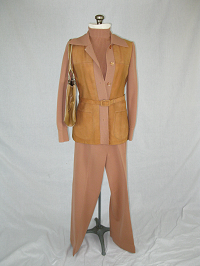
- Details
- Category: 20th century
- Hits: 3948
1905-1913
At the beginning of the 20th century, the shirtwaist and skirt were the working clothes of many women working in the business offices of cities and towns. The skirt was to fit tight at the top and falls in graceful folds at the foot. This was achieved either by gores or by an additional flounce.
McCall’s Pattern Company had been in business about 40 years, had many different skirt styles in their books. Everything from a 2-piece skirt to a 9-gored flared skirt. From the 1890s skirts were tight to the hips and flared below the line. Gloves. Hat.
Click photo for detailed views.
- Details
- Category: 20th century
- Hits: 2563
1910
Margaret Leet Beckman, a member of the well-known Baker family of Altoona, Pennsylvania might have worn a gown like this for her wedding in 1910. Her actual attire is unknown, but a woman of her status would have contracted with a dressmaker to construct the gown. City directories of the time list many women as dressmakers. Labels sewn into several gowns in the collection of the Blair County Historical Society, attest to their skill. This gown is in the princess style in shades of white, with three different laces. The stand collar is edged in lace. The side S-curve is evident in the bib of lace in the front and a small bustle in the back. The corset at this time pushed the woman’s bosom out in front and derriere out in the back. Veil is attached to a comb in her upswept hair. The full length sleeves are tiered corded and lace fabric.
Click photo for detailed view.
- Details
- Category: 20th century
- Hits: 2519
1940s
By the end of the 1930s and early 1940s the world was at war again. Men went to war, women went to work on the home front. Shoulder pads and emphasis indicate 1940s for this red wool suit. Hem lines which had gotten longer in the thirties now rose again with the shortage of cloth. In 1945 the masculine look was in. Rosie the Riveter wore a head scarf and pants to work. Wide shoulders and full sleeves. 1947 launched the wasp waist, shirt waists, bolero or jacket dresses. Strapless evening gowns of the late 1940s sparked the development of combined bra and suspender belt. Short haircuts with an irregular fringe. Accessories included a black hat and veil, gloves and purse.
By the 1940s, the influence of World War II is seen in the military details of fashion. The shoulder line is now wide and padded. Bust and waist are marked, and the hip is slim. To balance the silhouette, a large-brimmed hat was worn. Throughout the war, designs were relatively unchanged, freezing the silhouette for several years, since any change in fashion would mean changes in manufacturing equipment, techniques and labor. Wool, silk, rubber, leather, nylon were needed for the war effort and were used sparingly. Skirts were limited to 72 inches with a hem depth of less than two inches. Blouses were constructed without turned back cuffs. Even men’s clothing was reduced to single breasted suit with no vests and one pair of pants, without cuffs or pleats.
Click photo for detailed view.
- Details
- Category: 20th century
- Hits: 2441
1970s
Pant suits became popular for professional women throughout the decade. A tunic or waistcoat was worn over matching trousers. Gloves disappeared, and hats were only worn for special occasions. Individualism was on display in the many styles, including A-line, princess, shirtwaist, halter and the trouser suit. High heels and platform shoes returned during the early 1970s.
Click photo for detailed views.
- Details
- Category: 20th century
- Hits: 2409
1906
This velvet afternoon dress was copied from a picture of a 1906 gown in the Cincinnati Museum of Arts collection. The outfit defines the waist and shows the curve of the hips. Fashion decreed a small waist but large hips. Pads were used about and below the waist if needed. Black beaded medallions embellish the skirt and ribbon highlights the bodice. The bottom of the skirt has pleats to add to its circumference. The lace pinafore is worn over a lace blouse which has the high neck and ribbon bands.
While today most women have short hair, during the Edwardian age it was not cut. A woman's hair was something she treasured whether it was in good condition or not. They used home brewed products containing such ingredients as castor oil or petroleum jelly. The need for such products gave rise to companies such as Cody and L'Oreal. L'Oreal invented the first hair coloring and Charles Nestle invented the first permanent wave machine in 1905. It took 8 hours. Other forms of beauty culture being introduced at this time were electrolysis, chin straps to cure a double chin, and "Trilene" tablets to reduce weight without a change of diet.
Through the years fashionable clothing has had a proper foundation which supported the human figure by pushing, pulling and padding it into the proper shape for each new design. Underclothes were given lyrical titles, drawers became knickers. The chemise developed into combinations. The rustle of silk is disappearing at this time in favor of flimsy cotton petticoats and not more than two were used. The top of one, if colored, was called an underskirt. Evening petticoats were more elaborate and fashioned of glazed silk with deep flounces, frills, pin tucks and ruching. Some even had pockets just above the flounce. With the introduction of slimmer skirts the pockets were necessary for evening. During the day the pocketbook had been reintroduced to carry your handkerchief, latch key and powder.
Click photo for detailed views.
Page 5 of 6





